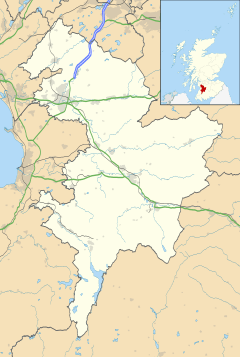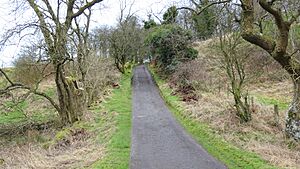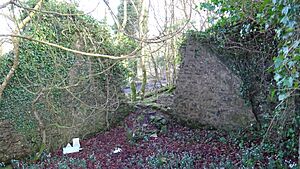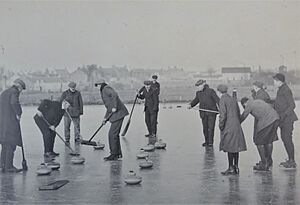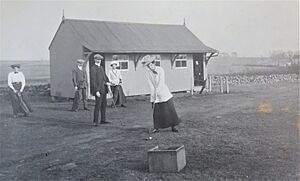Lands of Templehouse facts for kids
Quick facts for kids Lands of Templeland of Dunlop Hill
|
|
|---|---|
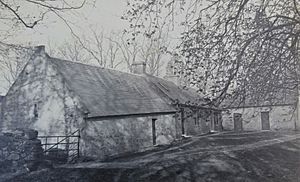 Templehouse in 1913 |
|
| OS grid reference | NS403488 |
| Council area | |
| Lieutenancy area | |
| Country | Scotland |
| Sovereign state | United Kingdom |
| Post town | Kilmarnock |
| Police | Strathclyde |
| Fire | Strathclyde |
| Ambulance | Scottish |
| EU Parliament | Scotland |
The Lands of Templehouse was a small estate located between Aiket Castle and the town of Dunlop in East Ayrshire, Scotland. The main house, officially called Templeland of Dunlop Hill, stood near an old road. This road connected Dunlop to Kirkwood and then to Kennox.
The Knights Templar, a famous medieval order of knights, owned these lands for a long time. Before 1570, the Gemmell family took over the property and lived there for about 500 years, until 1962.
Contents
History of Templehouse
The Gemmells were originally small landowners, sometimes called 'bonnet lairds'. This name came from the simple hats or bonnets they wore, similar to working people. They often married into other farming families, as shown on their gravestones in Dunlop churchyard.
The Templehouse property was also known as Temple House or Tempilhouse. Its formal name was "the tempillandis of Dunlophill". Sadly, a fire at Templehouse in the 1700s destroyed many family records. Because of this, we don't have proof of the Gemmells living there before 1474. Even today (in 2020), local people still call the place "Minnie Gemmell's" after the last person who lived there.
The Main House and Farm
The name Templehouse reminds us that the Knights Templar once owned these lands. In 1856, a map showed a walled garden at Templehouse, similar to one at Borland. This garden was over half an acre in size and had tall walls. It had a gate for vehicles facing east and steps for people to enter from the north. Paths inside the garden divided it into four squares, which were likely planted with trees like an orchard.
The house itself was said to have large roof slates, very small rooms, and special stepped gables on the roof. One room might have even had a curved, painted ceiling. We don't know how much damage the 18th-century fire caused, which might explain why older parts of the building are no longer visible.
In 1913, the farm included two cottages attached to a barn. There was also a separate building that might have been used for animal feed or as a stable. The cottages have nicely carved stonework and might be from the early 1800s. The walled garden was built right onto the side of the western cottage, which was unusual. There are no clear signs of a large, grand house that a laird would typically live in.
A large yard was in front of the buildings, but it's now covered with rubble. Roads connected the house to other nearby farms. There was also a small quarry nearby. This quarry might have provided the stone for the walled garden.
Around 1855, Templehouse was described as "A neat farm house with outbuildings and an excellent garden attached, the property and residence of John Gemmell Esqr."
The Knights Templar in Cunninghame
The Knights Templar owned many lands in the area called Cunninghame. In the early 1600s, Robert Montgomerie gained control of these Templelands. This was important because these lands were almost free from taxes. Around 1720, the lands passed to the Wallaces of Carnell. Later, Dr. Robert Patrick bought the rights, but these rights became less valuable after 1747 when old feudal laws were changed.
The Gemmell Family
It can be tricky to trace the Gemmell family tree because many first sons were named John, and Patrick was also a very common name.
In 1425, a John Gemmell held Templehouse. By 1474, Johnne Gemmill (spelled differently then) was the heir to Templehouse. This included other lands like Holehouse, (East) Netherhill, and Thorn.
In 1559, Patrick Gemmell was given Templehouse by the Temple Court in Ayr. The feudal superior, who granted the land, was John Spottiswood.
Patrick Gemmell was born at Templehouse in 1590. He married Margaret Montgomerie, and they had a son named Robert in 1620. Robert married Janet Baird, and they had a daughter, Janet, in 1650. Another son, John, married Agnes and had children named John, William, and David.
There's a story that one of the Cunninghames from Aiket had a conflict with a Gemmell at Templehouse. This likely happened in January 1601. Thomas Cunninghame and others broke into Templehouse and forced Patrick and his wife out of their bed. His wife was tied up, and Patrick was pressured to give them his silver and gold. He refused, and the burglars took valuable items they could find. Patrick was also taken prisoner and forced to travel far from Templehouse during a storm.
In 1596, Patrick Gemmell gave up the Templelands of Dunlop Hill to the Superior, Lord Torphichen. This was so his eldest son, John, could have them. John married Isobel Ross and had a son, also named John. This younger John married Elizabeth Howie. Both Johns died before the elder Patrick Gemmell. So, the brother of the eldest son, also named Patrick, received the lands.
In 1656, Patrick's son, John Gemmell, received a special document to hold Templehouse with his future wife for as long as either of them lived.
John Gemmill (born 1700, died 1784) of Templehouse married Janet Dunlop (born 1702, died 1742) of Holehouse in 1724. Their second son, John, inherited Holehouse. A descendant of Janet, John A. Gemmill, replaced their gravestone in Dunlop in 1897. Their eldest son, Patrick, inherited Templehouse.
In the early 1700s, Mary Mackie married Patrick Gemmell of Templehouse.
In 1754, John Gemmell received the lands of Templehouse from his grandfather.
In 1789, John's grandson, also named John, inherited the property. This was because his father, Patrick, had passed away before his own father.
In 1796, John Gemmell of Templehouse placed a memorial stone in Dunlop for his father Patrick. The stone also remembers John's son Patrick, who died at age 12 in 1810.
John Gemmell's son, another John, inherited Templehouse. Around 1866, his son John was the owner.
In 1874, John Gemmell was followed by Patrick Gemmell of Templehouse. Patrick married Janet Chalmers. They had two daughters, Mary Anderson and Jane Brown.
Three Gemmell sisters later bought Templehouse, along with about 50 acres of land. They lived there for the rest of their lives. In 1935, church records show Miss Alice Gemmell at Loanhead, and Margaret and Minnie Gemmill at Templehouse. Minnie was the last person to live at Templehouse. She lived there without electricity or running water until she passed away in 1962. No heirs could be found, and Minnie didn't make a will. She wanted the property to go back to the crown. Today, the house and walled garden are completely in ruins.
Some members of the Gemmell family from Templehouse moved to Ireland in the early 1600s during the Plantation of Ulster. Many Gemmell family memorial stones can be found in the Dunlop Church cemetery.
Nature at Templehouse
The site has several large sycamore trees, along with some ash and oak trees. In spring, the old walled garden is full of snowdrops, which are not native to the area but were often planted on estates. You can also find the rare winter heliotrope, which is also not native. Other plants like sweet woodruff and bluebells, which are signs of old woodlands, are present.
The invasive rhododendron has been planted here too. Hart's tongue ferns grow well on the lime mortar of the ruined walls, as do maidenhair spleenworts.
Dunlop Golf Course
The Dunlop Golf Club Course had nine holes. It first opened at Hapland in 1908. But in 1909, it moved to Templehouse and stayed there until it closed in 1922. People said the course was "of a sporting character, being varied and undulating.". It was about a twelve-minute walk from the train station.
In 1914, the membership fee was 10 shillings for men and 5 shillings for ladies, which was very cheap. There were 150 members. Visitors could play for 1 shilling a day or 2 shillings and 6 pence a week. Playing on Sundays was not allowed. The only thing left of the golf course today is a bunker that looks over the ruins of Templehouse.
Curling Pond
The Dunlop Curling Pond was still in use in 1913. It was located on the land near Templehouse, in a spot still known locally as Minnie's Meadow (as of 2020). This pond was supplied with water from the Hill and Templehouse Burns.
Images for kids


